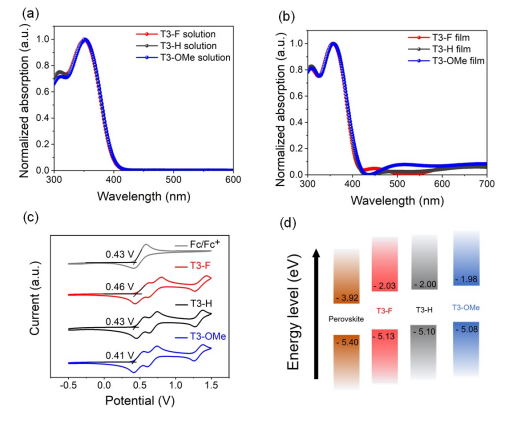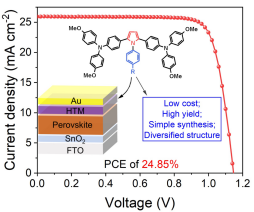Recently, Yi Chenyi’s research team from the Department of Electrical Engineering and Applied Electronics, Tsinghua University designed and synthesized a new type low-cost hole transport material T3 based on pyrrole substituted by triphenylamine, which and can efficiently tune the hole transport performance. The perovskite solar cells (PSCs) made of this material present a high photoelectric conversion efficiency (PCE) of 24.85%, and the relevant achievement was published in the international academic journal “Angewandte Chemie”.
Hole transport materials with high hole mobility and suitable energy band position, which can be easily prepared, are crucial for the development and application of perovskite solar cells. However, the 2,2',7,7'- tetrakis [N,N- di(4-methoxyphenyl) amino]- 9,9'- spirobifluorene (spiro- OMeTAD) is difficult to synthesize and expensive to satisfy the requirement for large-scale application of perovskite solar cells, while the efficiency of perovskite cells made of other hole transport materials is far from that of spiro-OMeTAD due to poor material film morphology, low carrier mobility and energy level mismatch with perovskite.
Therefore, Yi Chenyi’s team of Tsinghua University designed and synthesized a new type of hole transport material T3 based on the structure of pyrrole substituted by triphenylamine. Through the reaction of diacetylene derivatives with anilines containing different substituents, a variety of pyrrole derivative materials with different substituents (such as T3-F, T3-H, T3-OMe, etc.) can be efficiently synthesized is a simple process and low cost, and new substituents can be introduced through the final reaction step to realize tuning the film morphology, carrier mobility and energy level position of the material.

Schematic diagram of the synthesis route of hole transport material T3

Schematic diagram of energy level position characterization of hole transport material T3
A comparative study on T3 derivatives containing different substituents showed that the introduction of fluorine atoms can not only effectively improve the solubility and film morphology of the material, but also make the energy level between the material and the perovskite better match, thereby reducing energy loss. In addition, the interaction between fluorine atoms and uncoordinated lead atoms on the surface of perovskite can also passivate the surface defects of perovskite, which is beneficial to improve the performance of solar cells.

Schematic diagram of solar cell structure and PCE using material T3
The perovskite solar cells using T3-F as the hole transport material outstanding excellent photoelectric performance, and the cell efficiencies are 24.85% and 24.03% respectively (the certified efficiency is 23.46%) for 0.10cm2 and 1cm2, which is one of the topmost reported efficiencies for 1cm2. In addition, cells made of this material exhibit good stability, maintaining more than 80% of their initial efficiency after operating under continuous light for 1350 hours or after being stored in air for 3000 hours. The structural scalability of T3 provides makes it possible to further optimize the comprehensive performance of the material, and there is a great potential in applications such as organic optoelectronic devices and high-performance perovskite solar cells.
The achievement was published in the international academic journal “Angewandte Chemie” under the title “Tuning Hole Transport Properties via Pyrrole Derivation for High-Performance Perovskite Solar Cells”. The corresponding author of the paper is Yi Chenyi, the first author is Zhou Junjie, a doctoral student of EEA, and the collaborators include Professor Yang Junliang from Central South University and Professor Hua Ruimao from the Department of Chemistry, Tsinghua University. The work is supported by the National Key Research and Development Program, the National Natural Science Foundation of China, the Independent Scientific Research Project of Tsinghua University, the Independent Scientific Research Project of the State Key Laboratory of Power Systems, and the Scientific Research Project Fund of National Bio-Energy Group, State Grid.
Paper link: https://onlinelibrary.wiley.com/doi/10.1002/anie.202300314

















 News & Events
News & Events